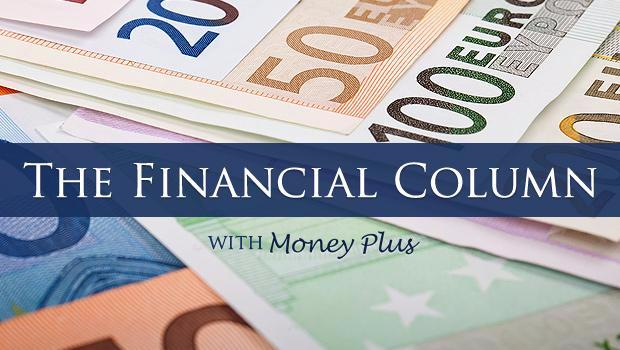The Financial Column

Welcome to this week’s Financial Column in association with Money Plus, Bridge Street, Boyle.
There has been a lot of volatility in stock markets over the last 6 months with share values falling. This has continued into 2016. In such periods it is not unusual that existing investors become concerned and anxious. However, in our experience short term fluctuations can end up distracting investors from their medium and long term investment objectives. With this in mind we thought it might be of benefit to share with you a summary of the current views of Alan McIntosh, Chief Investment Strategist at Quilter Cheviot, a leading fund manager and a business partner of Money Plus.
Financial Markets – Investment Update
‘Equity markets have suffered a difficult start to 2016, with global share prices falling by around 5% in the first full week of trading. The trigger for this has been, once again, concerns about China. To followers of chaos theory, the Chinese butterfly has flapped its wings and caused a storm elsewhere. But is it just a storm in a (China) teacup? Some perspective is called for. Much comment has been made about the sharp fall in the Shanghai stock market, with the exchange closing twice last week after trading limits were breached. However, the stock market is still in bubble territory, having risen by 150% over the eighteen months to last June. In reality there is very little foreign money tied up in Chinese shares – certainly not enough to cause instability in global markets. Equally, there is very little link between the stock market and the economy. The 150% rise occurred precisely when the economy was slowing.
Of more concern, however, has been the manipulation of the currency – the renminbi – by the authorities. A series of unannounced “depreciations” against the US dollar in the last couple of weeks has sparked fears of a currency war. A similar event took place last August as the rate against the dollar was adjusted several times, prompting concerns about the underlying health of the economy. Again, a bit of perspective is called for. The cumulative move in the currency over the last fortnight amounts to about 2%. Adding the change in the rate last summer gets you to around 5% in total. This is hardly earth shattering news. The pound has moved by even more against the dollar over the same period. However, these continuous clumsy interventions by the authorities have sapped confidence to the extent that investors are nervous about what happens next in China. The danger, of course, is that this has been blown out of proportion.
Even factoring in the anticipated slowdown in the Chinese economy, there is still enough positive momentum in the rest of the world to suggest that the there is no reason to be too negative. Last week’s employment data from the US points to an economy that is still growing healthily. Markets took December’s interest rate rise in their stride, but the likelihood of a sharp rise in borrowing costs from here looks slim. Although manufacturing activity has been faltering of late (partly a function of a strong dollar), the overwhelmingly large services sector is still comfortably positive. Meanwhile, lower oil prices continue to provide a boost for consumers, meaning that consumption can rise without recourse to borrowing. In Europe, manufacturing is improving, helped by a weaker euro. Continuing low levels of inflation should ensure that the central bank will carry on stimulating the economy. Lower energy prices are also providing a welcome fillip to Eurozone household budgets. Here in the UK, the economy is still set to expand by over 2% this year, with consumer confidence remaining strong. This is reflected in the record level of new car sales seen last year.
Turning to oil, there has been another sharp lurch downward in the price. The evidence suggests that demand remains fairly stable. Rather it is the increase in production of oil and resulting higher inventories that are pushing price levels lower. Ironically, the breaking of diplomatic ties between Saudi Arabia and Iran, which might once have led to oil prices soaring, have had the opposite effect. The likelihood of the two oil producing nations coming to an agreement to limit the future production of oil is now further away than ever. While the oil price down at these levels has a negative impact on producing nations, there is still a net positive benefit for the global economy as a whole (think the opposite of the oil price hike of the 1970s and its dire subsequent impact).
Finally, turning to equity markets themselves. Valuations are not overly stretched compared with the last twenty years, particularly after last week’s move. The recent fall in energy and commodity prices should keep inflation lower for longer, with the consequence that central banks will be thinking very carefully before moving interest rates higher. A combination of modest economic growth and low inflation and low interest rates is a fairly benign one for equities. There is no sign that consumer spending is out of control here or in the US, but confidence remains positive as disposable incomes improve. There is also evidence that business investment is picking up, particularly in the US. All of this suggests that if the Chinese butterfly continues to flap its wings, we should not, indeed, have any reason to panic.’
“Alan McIntosh, Chief Investment Strategist”.
Warren Buffets age old mantra has never reigned so true; “Be fearful when others are greedy and greedy when others are fearful”
If you have any questions regarding your investments or would like to review your existing investment portfolio please contact Belinda McCauley at Money Plus, Bridge St, Boyle on 071-919 4000/086-7847827 or by email: [email protected].
Boyletoday.com/MoneyPlus accept no responsibility for any decisions taken as a result of advice provided in this column. A reliable recommendation can only be made following a full detailed consultation taking an individual particular circumstances into consideration



